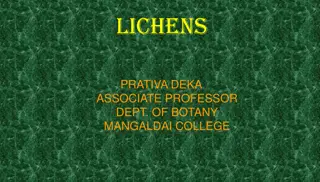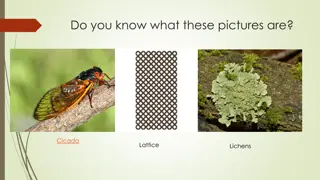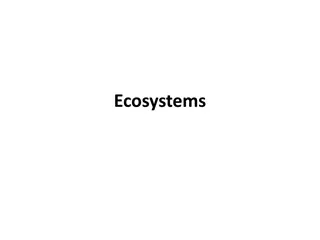Introduction to Lichens: General Overview, Classification, and Economic Importance
Lichens are symbiotic organisms composed of fungi and algae, with the algal component synthesizing food while the fungal component provides structure. They have unique characteristics and are classified based on their fungal partner, thallus forms, and habitat. Ascolichens and Basidiolichens are two main categories based on the type of fungi involved. Lichens play a crucial role in various ecosystems and have economic significance in medicine, agriculture, and environmental indicators.
Download Presentation

Please find below an Image/Link to download the presentation.
The content on the website is provided AS IS for your information and personal use only. It may not be sold, licensed, or shared on other websites without obtaining consent from the author.If you encounter any issues during the download, it is possible that the publisher has removed the file from their server.
You are allowed to download the files provided on this website for personal or commercial use, subject to the condition that they are used lawfully. All files are the property of their respective owners.
The content on the website is provided AS IS for your information and personal use only. It may not be sold, licensed, or shared on other websites without obtaining consent from the author.
E N D
Presentation Transcript
LICHENS General Characters Classification Types Economic Importance
What are Lichens? Lichen is a symbiotic association between algae and fungus. They are composite or dual organisms, formed by a close association of two different plants, one is filamentous fungus and other is alga. Theophrastus first used the term lichen to denote superficial growth on bark of trees. The study of Lichens is called Lichenology. Arik Acharium is regarded as Father of Lichenology .
General Characters It is a symbiotic association between alga and fungus. The algal component is called Phycobiont and the fungal component is called Mycobiont. The fungal component forms the bulk of the lichen thallus. Lichens have their own physiology. The fungal component obtain food either saprophytically or parasitically from the alga. The algal component synthesizes its own food from carbon dioxide and water.
The algal component in the association may belong to the Cyanophyceae or Chlorophyceae. The common Cynophycean (BGA) members are Nostoc, Rivularia, Scytonema, Cladothrix and Gloeocapsa. The common Chlorophycean (green algae) members are Trebouxia, Coccomyxa, Myromecia and Trentepohila. Some of the common examples of Lichens are Parmelia, Cladonia, Ramalina and Usnea.
Classification of Lichens Lichens are classified on the basis of -- 1. Nature of fungal partner 2. Forms of Lichen thallus 3. Habitat
On the basis of fungal partner Ascolichens Basidiolichens
Ascolichens The lichens in which the fungal components belong to the ascomycetes are called ascolichens. They are further divided into two sub classes- i) Gymnocarpae: in which the ascocarp is disc like. Ex. Parmelia flavicens ii) Pyrenocarpae: In which the ascocarp is flask shaped. Ex. Physcia sp.
Basidiolichens The lichens in which the fungal components belong to the basidiomycetes are called basidiolichens. Ex. Cora, Corella, Dictyonema.
On the basis of forms of thallus Crustose (Crustaceous) Foliose (Folioceous) Fruticose (Shruby)
Crustose Thallus is flat, thin and closely adherent to the substratum. It is just like a thin layer or crust closely attached to rocks or bark of trees. The surface of the thallus is divided into more or less hexagonal areas called the aerolae. Ex. Graphic scripta, Haematomma puniceum, Lecidea platycarpa.
Filiose Thallus is flat, broad, much lobed and leaf like. It resembles with crinkled and twisted leaves. Found attached to rocks and twigs by rhizoid like outgrowths called rhizinae which arise from lower surface. Rhizinae functions as anchorage and absorptive organ. Ex. Parmelia, Physcia, Peltigera, etc.
Fruticose Thallus is most complex, slender and freely branched. Branches are cylindrical or ribbon like, either upright or pendulous. They are attached to substratum by a disc like structure. Ex. Usnea, Cladonia and Ramalina.
On the basis of habitat Saxicolous rock lovers Corticolous bark of trees Terricolous terrestrial/land























